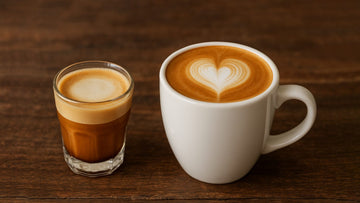When you walk into a specialty coffee shop, the menu can sometimes feel overwhelming—especially when you spot drinks like piccolo and latte. Both are espresso-based and use milk, but their size, flavor, and drinking experience differ quite a lot. If you’ve ever wondered whether to order a piccolo or stick with a classic latte, this guide will help you understand the key differences between these two delicious beverages.
What Is a Piccolo Coffee?
The word piccolo means “small” in Italian, and that’s exactly what this drink is: a small latte-style coffee.
-
Size: Small (3–4 ounces)
-
Espresso: One shot
-
Milk: Steamed milk with a light foam layer
Because it’s milk-based but not drowned in dairy, a piccolo offers a stronger coffee flavor with a creamy texture. Think of it as a mini latte with a punch of espresso strength—perfect for coffee lovers who want a quick, bold sip without the heaviness of a full-sized latte.
What Is a Latte?
A Latte, short for Caffè Latte, is a classic Italian coffee drink that’s beloved worldwide.
-
Size: Large (8–12 ounces)
-
Espresso: One or two shots
-
Milk: Mostly steamed milk with a thin foam layer
Compared to a piccolo, the latte is creamier, milkier, and much more filling. The larger ratio of milk softens the intensity of the espresso, making it a smoother, sweeter, and more approachable drink for those who don’t want their coffee too strong.
Main Differences Between Piccolo and Latte
1. Size and Strength
The most obvious difference is the size. A Piccolo is small and concentrated, offering a stronger coffee flavor per ounce. A Latte is larger and milkier, resulting in a milder taste.
2. Milk-to-Coffee Ratio
Piccolo has a higher coffee-to-milk ratio, making it bolder. Latte has more milk, creating a creamier, smoother drink.
3. Serving Style
Piccolos are often served in small glasses, highlighting their layered appearance. Lattes are typically served in larger mugs or cups and are sometimes decorated with latte art.
4. Origin and Popularity
While both have Italian-inspired names, the Piccolo is often associated with Australian coffee culture, whereas the Latte is a global staple.
Piccolo or Latte—Which One Is Right for You?
Choose a piccolo if you:
- Want a bold coffee taste with less milk
- Prefer a smaller, less filling drink
- Need a quick caffeine kick
Choose a latte if you:
- Enjoy a smooth, creamy coffee experience
- Like to sip slowly while working or relaxing
- Want a versatile drink you can customize with syrups or latte art
How to Make Café-Quality Coffee at Home?
The best part? You don’t need to wait in line at the café to enjoy these drinks. With a few key tools and some practice, you can enjoy café-quality coffee anytime. Here’s your ultimate guide.Essential Equipment
-
Espresso Machine: The best option for authentic results, as it provides the pressure needed for a true espresso shot and has a steam wand for milk.
-
Milk Frother: An espresso machine's steam wand is ideal. Alternatives include a handheld electric frother, a French press (for pumping to create foam), or a stovetop steamer.
-
Grinder: For the freshest taste, use a burr grinder to grind coffee beans right before brewing.
-
Jugs: Small pitchers for steaming and pouring milk.
-
The Right Cups: A small 3-4oz glass for the Piccolo and a larger 8-12oz mug for the Latte.
Step-by-Step Process
Step 1: Brew the Espresso
Grind 18-20 grams of coffee beans to a fine espresso consistency. Tamp firmly and brew a rich espresso shot.
For Piccolo: Brew a single shot (30ml/1oz) directly into your small serving glass.
For Latte: Brew a double shot (60ml/2oz) into your larger mug.
Step 2: Steam the Milk
Piccolo: Steam a small amount of milk (fill jug 1/3 full) to create velvety microfoam. Heat to around 65°C (150°F).
Latte: Steam more milk (fill jug halfway), introducing slightly more air for 2-3 seconds to create a thin foam layer. Heat to 65°C (150°F).
Step 3: Pour and Serve
Tap the milk jug gently on the counter to pop large bubbles and swirl to integrate the foam.
Piccolo: Slowly pour steamed milk over espresso, using a spoon to hold back foam until the end for a thin layer on top.
Latte: Pour from a low height into the center of the espresso. As the mug fills, bring the pitcher closer to the surface. For latte art, use a wiggle motion while pouring.
-
Always start with cold milk and a cold pitcher
-
Practice milk steaming - it's an art that improves with time
-
Keep your steam wand clean by purging before and after use
-
Use freshly roasted, high-quality beans for the best flavor
-
Whole milk creates the best microfoam texture
Conclusion
Both piccolo and latte are delicious in their own ways. The piccolo highlights espresso’s bold character, while the latte offers a smooth, milk-forward treat. Now that you understand the differences and techniques, you're equipped to choose wisely at coffee shops and create both exceptional drinks at home anytime!






